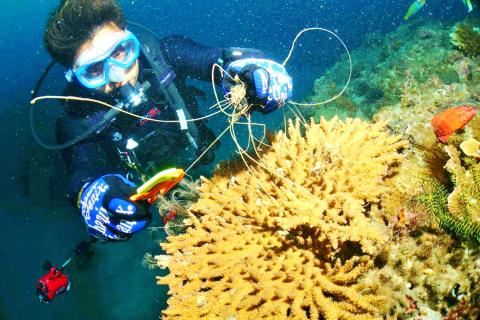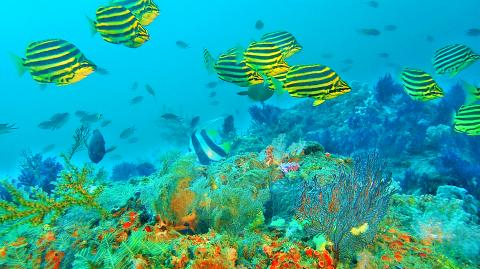Later this month, Taipei-based scuba divers Lin You-ping (林祐平), Tsai Chih-tung (蔡志童) and Luo Wen-yang (羅汶揚) will drive down to Kenting to do what they would normally do in Keelung — untangle fishing nets from corals and collecting bottles and other bits of trash from the seabed.
The trio met learning to scuba dive in Keelung more than three years ago. Not long after, Lin founded the organization, Diving TW (揪潛水同學會). Though its initial purpose was simply to get divers together and organize dives, the group soon took on an environmental and educational focus when Lin and the other divers started noticing trash in the ocean during their dives, and felt compelled to do something about it.
AWASH WITH GARBAGE

Photo courtesy of Lin You-ping
A typical day begins at 6:30am. The men drive to Keelung with their dive gear, put on their wetsuits, go on one or two dives and haul piles of garbage — fishing nets, rope, bottles, cigarette lighters, pieces of dead coral — back to their boat, before driving back to Taipei to clock in at their office jobs.
Tsai didn’t think too much of it the first time he saw nets and bottles during a dive.
“It was just there and I didn’t really pay any attention to the larger significance,” Tsai tells the Taipei Times.

Photo courtesy of Lin You-ping
However, the more trash he saw on subsequent dives, the more this started to bother him.
“I didn’t sign up to go scuba diving to see trash,” Tsai says. “I did it because I wanted to enjoy the beauty of the ocean and see the different types of marine life.”
Lin was also indifferent at first, though like Tsai, with each dive it began to upset him more, especially when he realized that ocean trash was a huge problem that plagued not just Keelung, but most of Taiwan’s east coast, which faces the Pacific Ocean.

Photo courtesy of Lin You-ping
“I had the opportunity to see how beautiful and amazing it is underwater and I felt sad that we were ruining it,” Lin says.
FISH FOR THOUGHT
Lin discovered a lot of the nets were discarded by fishermen who would leave it in the ocean if it got tangled in a reef, which traps the fish. Another issue has been fishermen throwing their nets into the ocean to catch fish, shrimp and crabs, but pulling out parts of coral reefs instead.

Photo courtesy of Lin You-ping
“They think, ‘after this area has no more fish left, I’ll just move onto another area,’ all the while not realizing that they’re ruining the habitat of aquatic animals,” Lin says.
Lin says attitudes toward food consumption is also fueling the problem.
“They don’t see fish in the ocean and think, ‘how pretty.’ They see it and think, ‘can this be eaten?’” Lin says.

Photo courtesy of Lin You-ping
Lin says he’s seen improvement in Keelung, where local fisheries have banned the use of gill nets, and where after being driven away from their habitat in the sea surrounding Chaojing Park (潮境公園), sea urchins have started to return.
OUT OF SIGHT, OUT OF MIND
The divers attribute the problem of ocean waste to a deep-rooted disconnect with nature — fostered from a young age when parents would tell their children that it is dangerous and haunted.

Photo courtesy of Lin You-ping
Knowing how to swim, Luo says, makes you appreciate your natural surroundings more because “you’ll swim out and feel struck by how big and gorgeous the ocean is and how blue the water is.”
Lin believes it’s more than just throwing trash in the ocean because it’s out of sight, out of mind. The problem, he insists, starts with how people in the city go about their daily lives.
“Just because we don’t live near the ocean, doesn’t mean that we’re not part of the problem,” Lin says.

From an anonymous office in a New Delhi mall, matrimonial detective Bhavna Paliwal runs the rule over prospective husbands and wives — a booming industry in India, where younger generations are increasingly choosing love matches over arranged marriage. The tradition of partners being carefully selected by the two families remains hugely popular, but in a country where social customs are changing rapidly, more and more couples are making their own matches. So for some families, the first step when young lovers want to get married is not to call a priest or party planner but a sleuth like Paliwal with high-tech spy

With raging waters moving as fast as 3 meters per second, it’s said that the Roaring Gate Channel (吼門水道) evokes the sound of a thousand troop-bound horses galloping. Situated between Penghu’s Xiyu (西嶼) and Baisha (白沙) islands, early inhabitants ranked the channel as the second most perilous waterway in the archipelago; the top was the seas around the shoals to the far north. The Roaring Gate also concealed sunken reefs, and was especially nasty when the northeasterly winds blew during the autumn and winter months. Ships heading to the archipelago’s main settlement of Magong (馬公) had to go around the west side

When Portugal returned its colony Macao to China in 1999, coffee shop owner Daniel Chao was a first grader living in a different world. Since then his sleepy hometown has transformed into a bustling gaming hub lined with glittering casinos. Its once quiet streets are now jammed with tourist buses. But the growing wealth of the city dubbed the “Las Vegas of the East” has not brought qualities of sustainable development such as economic diversity and high civic participation. “What was once a relaxed, free place in my childhood has become a place that is crowded and highly commercialized,” said Chao. Macao yesterday

For the authorities that brought the Mountains to Sea National Greenway (山海圳國家綠道) into existence, the route is as much about culture as it is about hiking. Han culture dominates the coastal and agricultural flatlands of Tainan and Chiayi counties, but as the Greenway climbs along its Tribal Trail (原鄉之路) section, hikers pass through communities inhabited by members of the Tsou Indigenous community. Leaving Chiayi County’s Dapu Village (大埔), walkers follow Provincial Highway 3 to Dapu Bridge where a sign bearing the Tsou greeting “a veo veo yu” marks the point at which the Greenway turns off to follow Qingshan Industrial Road (青山產業道路)